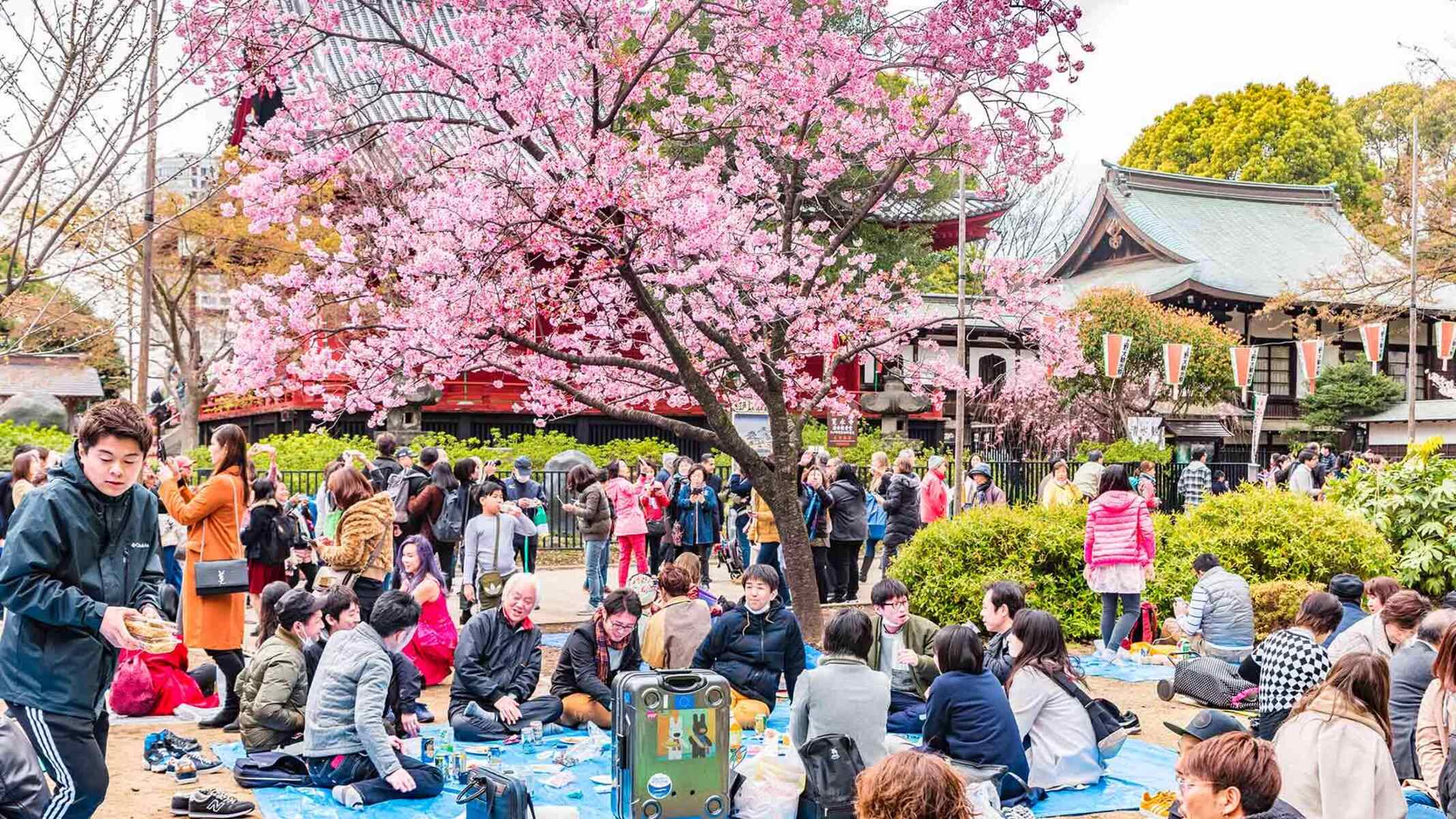
Hanami, or cherry blossom viewing, is a beloved Japanese tradition that attracts countless visitors from around the world. Every spring, people gather under the blooming cherry trees to celebrate the beauty of nature and the fleeting beauty of life. But there is more to hanami than just taking in the picturesque scenery.
In this article, we will explore 20 fascinating facts about hanami that will enhance your understanding and appreciation for this cultural event. From the origins of hanami to the symbolism behind cherry blossoms, you’ll discover the rich history and traditions that make hanami such a significant event in Japan.
So, if you’re curious to learn more about hanami and the enchanting world of cherry blossoms, let’s delve into these interesting facts that will deepen your understanding of this cherished Japanese tradition.
Key Takeaways:
- Cherry blossoms are a symbol of life’s beauty and fleeting nature, reminding us to cherish the present moment and appreciate the beauty around us during the brief but spectacular hanami season.
- Hanami is a traditional Japanese custom that has evolved over time, bringing people together to enjoy picnics, parties, and festivities under the blooming cherry blossom trees, creating a magical and enchanting experience.
Hanami is a traditional Japanese custom.
Hanami, which translates to “flower viewing,” is a centuries-old tradition in Japan that celebrates the fleeting beauty of cherry blossoms.
Cherry blossoms symbolize the beauty and transient nature of life.
The delicate cherry blossoms are seen as a metaphor for life itself, reminding people to appreciate the present moment and cherish the beauty that surrounds them.
The cherry blossom season typically occurs in spring.
Depending on the region and weather conditions, cherry blossoms usually bloom between late March and early May, transforming the landscape with their vibrant colors.
Japan is famous for its cherry blossoms.
Japan is world-renowned for its breathtaking cherry blossom displays, attracting millions of visitors from around the globe who come to witness the natural spectacle.
There are over 200 varieties of cherry blossoms in Japan.
Japan is home to a wide variety of cherry trees, each with its own unique characteristics and bloom times, offering a diverse and mesmerizing display of colors.
Hanami is a social event.
Hanami is not only about appreciating the cherry blossoms but also about gathering with friends, family, and loved ones to enjoy picnics, parties, and festivities under the blooming trees.
Sakura is the Japanese term for cherry blossoms.
The word “sakura” is used to refer specifically to cherry blossoms in Japan and has become synonymous with the springtime phenomenon.
The tradition of hanami dates back over a thousand years.
The practice of hanami originated during the Nara period (710-794) when plum blossoms were initially favored. Over time, cherry blossoms gained popularity and became the focus of hanami celebrations.
Cherry blossom forecasts are announced every year.
To help locals and tourists plan their hanami experience, cherry blossom forecasts are released, providing anticipated bloom dates for different regions in Japan.
Cherry blossom viewing was historically restricted to the elite class.
In ancient times, hanami was an exclusive event reserved for aristocrats and samurais. However, it later became a cherished tradition for people from all walks of life.
Hanami-inspired festivals are held worldwide.
The beauty and allure of hanami have inspired festivals and events in various countries around the world, where cherry blossom trees are planted and celebrated.
The most famous hanami spot in Japan is the Philosopher’s Path in Kyoto.
The Philosopher’s Path, nestled alongside the scenic Canal in Kyoto, is renowned for its picturesque cherry blossom-lined pathway, attracting crowds of visitors during the peak bloom.
Yozakura refers to nighttime cherry blossom viewing.
Yozakura, or nighttime hanami, offers a different and enchanting experience as cherry blossoms are illuminated, creating a magical ambiance under the starlit sky.
Cherry blossoms have inspired various forms of art.
The ethereal beauty of cherry blossoms has influenced numerous art forms, including painting, poetry, music, and traditional Japanese crafts.
Some cherry tree varieties produce edible cherries.
While most cherry blossom trees do not bear edible fruit, some varieties, such as the famous Somei Yoshino, produce small cherries that can be enjoyed.
Hanami parties often include traditional Japanese foods.
During hanami gatherings, people indulge in delicious Japanese delicacies, such as bento boxes, sushi, tempura, and sake, while surrounded by the breathtaking cherry blossoms.
The sakura bloom is brief but spectacular.
Cherry blossoms typically last for only a week or two, making hanami a cherished moment to witness the ephemeral beauty of nature and appreciate the fleeting nature of life.
Cherry blossoms have a cultural significance in Japan.
The cultural significance of cherry blossoms extends beyond their beauty, deeply rooted in Japanese traditions, literature, art, and even national identity.
Hanami is not limited to Japan.
The love for cherry blossoms has spread worldwide, and many countries, such as the United States, Canada, Korea, and China, also have their own cherry blossom festivals.
The custom of hanami has evolved over time.
While hanami still holds its traditional essence, modern celebrations often include concerts, themed events, and even fireworks, adding a contemporary touch to the cherished tradition.
Conclusion
In conclusion, hanami, or cherry blossom viewing, is an ancient Japanese tradition that holds great cultural significance. The beauty of the cherry blossoms, combined with the joyous atmosphere of gathering with loved ones, makes hanami a truly memorable experience. The 20 facts we’ve explored in this article shed light on the history, symbolism, and traditions associated with hanami. From the origins of hanami to the popular locations for cherry blossom viewing, there is so much to learn and appreciate about this cherished tradition. Whether you plan to participate in hanami yourself or simply admire the stunning photographs, let the beauty of the cherry blossoms inspire you to embrace nature’s fleeting moments of splendor.
FAQs
1. What is hanami?
Hanami is a traditional Japanese custom of enjoying the beauty of cherry blossoms.
2. When does hanami take place?
Hanami typically takes place in spring, usually from late March to early May, depending on the region and weather conditions.
3. Where can I experience hanami?
You can experience hanami in various locations throughout Japan, such as parks, gardens, and temple grounds.
4. What is the significance of cherry blossoms in Japanese culture?
Cherry blossoms symbolize the transient nature of life and the beauty of impermanence.
5. Are there any specific rituals associated with hanami?
While there are no strict rituals, it is customary to have picnics under the cherry blossom trees, known as “ohanami.” This usually involves enjoying food and drinks while appreciating the blossoms.
6. What is the most popular variety of cherry blossom in Japan?
The most iconic cherry blossom variety in Japan is the Somei Yoshino, known for its delicate white petals and pale pink hue.
7. Can you tell me more about hanami festivals?
Hanami festivals, or sakura matsuri, are held nationwide during the cherry blossom season. They often feature food stalls, traditional performances, and illuminated displays of cherry blossoms.
8. Are there any specific etiquette guidelines for hanami?
It is customary to be respectful of the environment and other visitors during hanami. This includes not littering, not damaging the trees, and not hogging the best viewing spots for too long.
9. How long do cherry blossoms typically last?
Cherry blossoms are notoriously short-lived, usually lasting for about a week. However, this can vary depending on the weather conditions.
10. Are there any other countries where hanami is celebrated?
Hanami is predominantly a Japanese tradition, but cherry blossom festivals have gained popularity in other countries as well, such as the United States, South Korea, and the United Kingdom.
Immerse yourself in the captivating world of cherry blossoms and beyond! Dive deeper into the fascinating facts about sakura, the iconic flower that has captured hearts for centuries. Discover the joys of outdoor gatherings with our picnic facts, perfect for planning your next hanami adventure. And for those seeking to explore nature's wonders, our guide to the best hiking sandals will help you step into your next outdoor activity with comfort and style. Embark on a journey of discovery and embrace the beauty of the world around you!
Was this page helpful?
Our commitment to delivering trustworthy and engaging content is at the heart of what we do. Each fact on our site is contributed by real users like you, bringing a wealth of diverse insights and information. To ensure the highest standards of accuracy and reliability, our dedicated editors meticulously review each submission. This process guarantees that the facts we share are not only fascinating but also credible. Trust in our commitment to quality and authenticity as you explore and learn with us.


